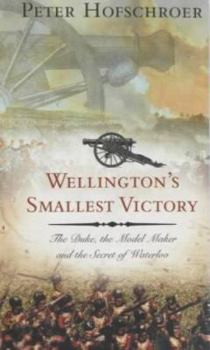Wellington's Smallest Victory: The Duke, the Model Maker, and the Secret of Waterloo
Select Format
Select Condition 
Book Overview
'A first-class work of historical investigation.' Andrew Roberts, author of Napoleon and Wellington The extraordinary story of how one man's obsession to build a huge model of Waterloo - the greatest... This description may be from another edition of this product.
Format:Hardcover
Language:English
ISBN:0571217680
ISBN13:9780571217687
Release Date:January 2004
Publisher:Faber & Faber
Length:324 Pages
Weight:5.40 lbs.
Customer Reviews
1 rating
The Iron Duke's Feet of Clay
Published by Thriftbooks.com User , 18 years ago
Visitors to London's Egyptian Hall in October 1838, like visitors to London's National Army Museum today, had a chance to marvel at a finely detailed model of the battlefield of Waterloo-the field of the Duke of Wellington's famous victory over the Emperor Napoleon. Capt. William Siborne, the modeler who made the diorama of Britain's greatest battle, found himself in a losing, lop-sided battle of his own with Wellington, the man Siborne wished to honor with his model by freezing Wellington's greatest victory like a fly in amber in the memory of Britons. Peter Hofschröer, author of previous studies of the Prussian army, Waterloo and Wellington's guarding of his role in that battle, has produced detailed a history of Siborne's battle to create an accurate model of the battlefield of Waterloo. Beginning with a description of the battle itself, the author moves swiftly to describe the multitude of panoramas and other shows put on in London exploiting the victory for commercial purposes. But the most lasting commemoration of the battle was to be that constructed by William Siborne. William Siborne, the son of a British officer, had attended the Royal Military College, graduating in 1814. As his regiment did not participate in the Waterloo campaign, Siborne missed out on serving in the Napoleonic wars, the defining event of the era. When the idea of a military museum in London and more specifically a model of the battlefield of Waterloo were discussed, Siborne's name was put forward as an officer who had knowledge in both topography and model-making. An expert who had written a standard textbook on topographical surveying and drawing, Siborne was employed at producing a model of the famous battle for the new United Service Museum. Siborne, living on the battlefield and using techniques and equipment he had developed, undertook a precise survey of the ground at Waterloo. Back in Dublin, Siborne began construction of his model, the process of which Hofschröer describes in detail. Two years were spent in constructing, painting and modeling the terrain. At the end of this period the first bump in Siborne's road to completing the model occurred-a change in government. Wellington was out and the opposition was in. A suddenly tight-fisted Whig War Office began to wonder about spending hundreds of pounds on what was, after all, a model honoring a Tory politician-even if it was the Iron Duke. Ready to set the figures in place, Siborne now found himself drawn into a controversy over the battle itself, a controversy which would bring Siborne into a clash with Wellington. By freezing a moment of the battle in time Siborne's model would offer visual evidence in the disputes that were going to continue for years over who did what, when and where in the great battle. To assist him in the task of accurately placing the highly detailed figures, Siborne proposed sending a letter to the officers of the various regiments involved. Though Siborne got perm





